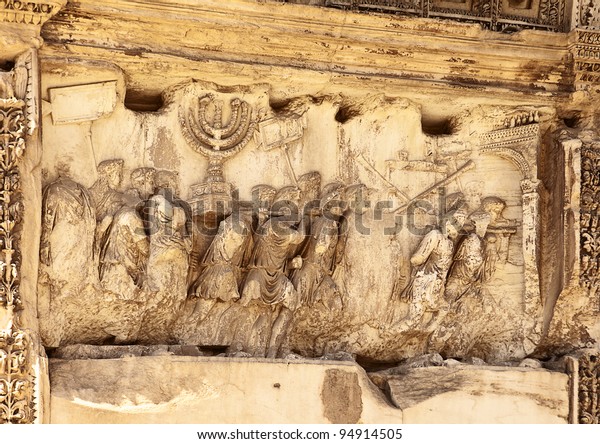
The air quality of Rome and all other cities, such as Athens, is a great problem for Classical structures and sculptures, especially for limestone, not granite so much. Quantifying the impacts of climate change, environmental issues, all impact the monument and its survival. Finding what we expected allowed for some confidence that other colors discovered or posited might be accurate as well. In fact, based on all literary sources back to the Bible, yellow paint- or perhaps gilding (which was not found) is the only possible color. It was no surprise when Heinrich and Rose Piening, conservators from Bavaria in Germany, identified the original yellow ochre paint of the menorah. Can you explain why this discovery is consistent with biblical, early Christian, and Talmudic writings, in particular to the eye-witness testimony by the first-century historian Josephus? You and your team found traces of yellow ochre on the arms and on the base of the menorah. The scan data was processed to create a 3D representation of the form on the menorah panel and the reliefs showing Titus riding in triumph through the city and the deification of Titus at the apex of the arch with sub-millimeter accuracy. The 2012 pilot project in search of color was a complete success. Students, licensed tour guides of Rome and tourists can benefit from this fantastic interview with Professor Fine about the history of the Arch of Titus in the Roman Forums. The sculpted depiction of these spoils was likely originally colored yellow, likely with a blue background, says Professor Steven Fine, Director of the Yeshiva University Arch of Titus Project. They are the main focus of a panel carved in deep relief on the Arch of Titus. The seven-branched golden Menorah, silver trumpets, and the golden Table of Showbread, taken as war spoils at the destruction of the Second Temple, have much significance to the Jews of Rome. And finally it was in Rome that all traces of the menorah vanished without a trace, never to be found again, says Ruth Dureghello, the first woman president in the history of the Jewish community of Rome. It was under Rome, that the menorah became a powerful and representative emblem of Judaism. In this process, sections of the exterior were rebuilt in travertine instead of marble, so that it could be distinguished from the original. Last but not least, it should be mentioned that the Arch of Titus served as a model for the Arc de Triomphe in Paris.It was to Rome that a menorah was brought from Jerusalem after the destruction of the Beit Ha Miqdash, the Temple, and was carried in triumph as war plunder by the imperial troops. In the 11th century, the Arch of Titus was integrated into a fortress, built by the Frangipani family, which contributed to the preservation of the monument. The reliefs were also colored and the arch was crowned by a bronze quadriga. The original bronze inscription in the decorative strip reads “The Roman Senate and the people to the deified Titus, Vespasian Augustus, son of the deified Vespasian”. The other panel shows Titus in a chariot accompanied by the goddess Victoria and the goddess Roma.



One shows the triumphal procession with the spoils from the second Temple of Jerusalem – the menorah, the silver trumpets and the table of showbread. On the inside of the arch, 15 meters high, there are two panels with reliefs.

The arch was inaugurated in 85 AD with great festivities. Emperor Domitian, Titus’ brother and successor, commissioned the construction of the Arch of Titus in the same year, both to honor his brother and to commemorate the victory in the Jewish War. In 70 AD, Titus conquered Jerusalem with four legions, and with the fall of the fortress of Masada in 72 AD, the rebellion was completely put down. In 79 AD Titus became emperor of the Roman Empire, but died just two years later. The popular emperor was soon after elevated to the status of god by the Roman Senate. The history of the Arc de Triomphe goes back to Titus, the son of Emperor Vespasian, who was sent to the province of Judea to put down an uprising of Jewish Zealots against the Roman occupation. The single-gate triumphal arch stands at the highest point of Via Sacra, which leads from the Roman Forum to the Colosseum, and is part of the archaeological site of the Roman Forum. The Arch of Titus is the oldest surviving triumphal arch of ancient Rome and one of three remaining imperial triumphal arches, along with the Arch of Constantine and the Arch of Septimius Severus. Essentials about the Arch of Titus in brief


 0 kommentar(er)
0 kommentar(er)
